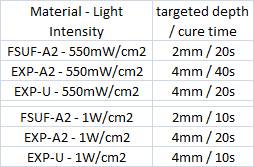Objectives:
The objective of this research was to confirm that a novel bulk-fill flowable composite was sufficiently cured at a target depth of 4mm. Sufficient cure was defined as equivalent cure to FiltekTM Supreme Ultra Flowable Restorative (FSUF) at its claimed depth of 2mm.
Methods:
The experimental material was shaded at 2 levels, a lightly pigmented shade, designated EXP-U, and an A2 shade, designate EXP-A2. Comparisons were made to FSUF-A2 shade.
The cure conditions, defined by time and light intensity, are outlined in the table below.
The targeted 4mm depth of cure was confirmed by the following methods:
Depth of cure: Depth of cure was measured per ISO4049:2009, 7.10.
Knoop Hardness: A sample was prepared that was a cylinder bisected along the height (hemicylindrical) to give a flat surface. The sample was cured from one end of the hemicylinder. Knoop hardness was measured as a function of depth (distance from light). The hardness at the targeted cure depth was then ratioed to the maximum hardness.
Degree of Conversion: Raman spectroscopy was used to determine degree of conversion (DC) as a function of depth. A hemicylindrical sample was prepared. Measurements were taken in an array of 0.3X0.3mm pixels (7 pixels wide past the targeted cure depth). The area of the 1636 and 1608 cm-1 bands for cured (polymer) and uncured (monomer) were ratioed to calculate degree of conversion using the following equation.
The DC at the target cure depth was then ratioed to the maximum conversion.
Adhesion: Adhesion to bovine dentin and enamel was measured by wire-loop methodology using a composite button of targeted cure depth.
Results:
Mean values and p-values vs FSUF are given in the tables below.
Conclusion:
The novel bulk-fill flowable composite exhibited statistically equivalent cure at a depth of 4mm as compared to FSUF at 2mm.
Keywords: Bulk-fill, Composites and Dental materials
![[ Visit AADR's Website ]](images/banner.jpg)



